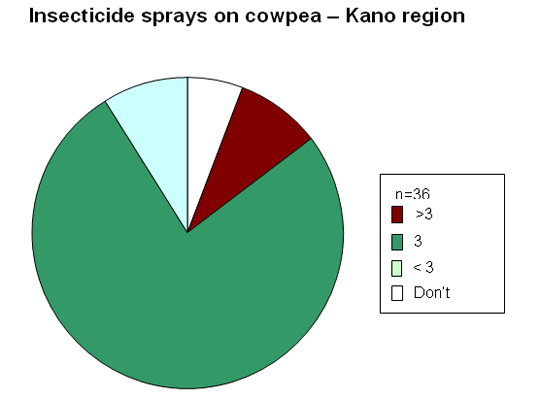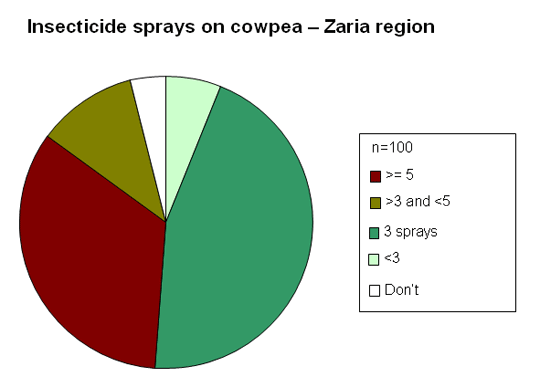Increase in insecticide use on cowpea in Africa - not surprising any more - a report by Venu Margam
Cowpea in West Africa is grown by mostly low-resource farmers as a food and small-scale cash crop (1). Numerous observers have noted that insecticide use on cowpea is heaviest in the moist regions of the West African cowpea belt, but diminishes as one moves to the drier zone where cowpea thrives. In some very high rainfall areas cowpea is simply not grown because the insect pressure is too high. Diversion of cotton insecticides to other crops including cowpea were reported in an earlier study (2). Because there are very few systematic studies of insecticide use practices on cowpeas in West Africa, more studies are needed on this aspect.
I visited Nigeria and Niger during the months of September and October of 2006 when cowpea was still in the field. This gave me an opportunity to observe cowpea growers and some of the issues involved in cowpea cultivation. This current report summarizes observations and some surveys done by me with help from the Bean/Cowpea CRSP collaborators in the Kano and Zaria regions of Nigeria and the Maradi region of Niger.
Data from these small-scale preliminary studies indicates a widespread, indiscriminate use of insecticides on cowpea, both in the field and storage, throughout the cowpea-growing region. Increases in pesticide-related agricultural extension activity and greater availability of insecticides in the local markets may be the probable causes for this unexpected high level of insecticide use.

|
|
Fenetrothion supplied by Agricultural extension agent, Guidan Sori, Niger. |
Much of the insecticide used in the Maradi region of Niger is imported from Nigeria via road transport. During my surveys, I talked to the quarantine inspector at the border village of Danissa in Niger. According to his records, considerable amounts of insecticides are brought into Niger from Nigeria. Insecticide trafficking is higher during the agricultural season, between the months of June and November.
|
|
Quarantine agent at the border village Dan Issa, Niger. Ledger showing amounts of insecticide brought into Niger.
|
Status of insecticide use in Nigeria –
While these surveys were being conducted, I interviewed an insecticide dealer/distributor in the Kano market. He said that most farmers who come to buy do not know what type of insecticide is needed for the pest on their crop. They describe to the dealer the problem or symptoms of damage and he, based on the farmers’ budget, recommends a particular insecticide.
|
|
Pesticide dealer, Kano city market, Nigeria. Pesticide shop in a small village in Niger.
|
In one village close to Kano, Nigeria, the farmers were using a local weed belonging to the genus Hyptis for control of storage insect pests of cowpea. Pounded plants of Hyptis sp. mixed with cow-dung are also used for plastering of grain storage bins made of bamboo. The farmers claim that Hyptis can protect the stored cowpeas for a period of 6 months, after which they start seeing the insects.
The following pie-charts summarize the data I collected on insecticide use and the number of pesticide sprays done by cowpea farmers in the Kano and Zaria regions of Nigeria. In the Kano region 72% of the surveyed farmers spray at least 3 times and 10% of the farmers spray more than 3 times, in some cases up to 7 sprays. There is even greater use of insecticides in the Zaria region, where only 45% of the surveyed farmers spray cowpea 3 times, while the percentage of those spraying more than 3 times is 45% (3 times higher than in Kano).


The following are some additional concerns associated with the high levels of insecticide use on cowpea;
Improper application: Multiple/repeated sprays of sublethal doses of pesticide poses a high risk that the insect pests will become resistant to these chemicals. Overuse of insecticides favors the emergence of resistant pest populations. Given the evident substantial use of insecticide on cowpea (see above), there is an urgent need for evaluating the resistance levels among pest species for some of these insecticides in the field as well as in the stored grain.
Lack of Personal Protection Equipment (PPE): When handling insecticides, farmers rarely use PPE. This poses a serious threat to their health and to other farm personnel handling them. I was also told by the pesticide-coordinator at Ahmadu Bello University about incidents related to insecticide use. He said that there had been some pesticide-related fatalities among the crop-protection personnel, while others had suffered neurological and ophthalmogical symptoms. The fatalities during the past few years were mostly related to lack of PPE. The threat to applicators is more serious when it comes to illiterate farm personnel with no education and no means to associate any illness with pesticide-related effects.
|
|
Farmer holding a food container with insecticide. Technician Salissou with a insecticide container with no label for identification.
|
Insecticides in stored grains: In addition to the lack of PPE, a more serious and un-researched issue is the presence of insecticides in stored grains. I learned during the surveys that there were frequent reports in the local/regional newspapers about individuals/families dying after consuming insecticide-treated grains/food3. In addition, I met farmers who were treating cowpea seeds for storage with highly concentrated liquid insecticide formulations (meant only for spraying on crops) for long-term storage. Such treated cowpea sometimes makes its way into the market either when the farmer is in need of money or when it is especially profitable to sell cowpea. Treated cowpeas, once in the market, can no longer be distinguished from normal untreated cowpeas and so the buyers have no way of distinguishing between the two.
Based on my observations and the data we have, the following are measures that need to be taken to improve the conditions of the cowpea farmers in West Africa;
- There is an immediate need for educating farmers on the use of PPE, handling insecticides, symptoms of insecticide toxicity and prophylactic measures to be taken after accidental exposure to insecticides. Cost of the PPE might be an issue initially, but once the farmers are informed of the importance of using PPE the cost issue might become minor.
- Training farmers in safer and cheaper methods of grain storage that do not require use of harmful insecticides.
- More systematic studies to document insecticide residues on cowpea in the markets and the number of cases where in people are getting poisoned due to insecticide residues in food grain.
The NGICA team at Purdue Entomology would like to hear from you about this issue of insecticide use on cowpea. Please send any comments or input on the status of insecticide use on cowpea in your region to Venu Margam at margam@purdue.edu or Dr. Barry Pittendrigh at pittendr@purdue.edu or Dr. Larry Murdock at murdockl@purdue.edu. Alternatively, comments can be posted to the NGICA email address ngicans@gmail.com .
Acknowledgements: I am grateful to my major professors Drs. Larry L. Murdock and Barry R. Pittendrigh at Purdue who have made this trip possible. I extend my sincere thanks to Dr. Mohammad Ishiyaku (Institute of Agricultural Research (IAR), Samaru-Zaria, Nigeria) and Dr. Ibrahim Baoua (Director, Institut National de Recherche Agronomique du Niger (INRAN), Maradi, Niger). I would also like to thank Humza (field technician, IAR) and Salissou (field technician, INRAN) for their assistance with data collection and translations during the interviews.
References
Langyintuo A.S., Lowenberg-DeBoer J., Faye M., Lambert D., Ibro G., Moussa B., Kergna A., Kushwaha S., Musa S., Ntoukam G. 2003. Cowpea supply and demand in West and Central Africa. Field Crops Research. 82(2): 215-231.
Williamson S. 2003. Pesticide provisions in liberalized Africa: out of control? Agricultural research and extension network. Paper 126.
“The Family of five dies after meal of rice and beans” in the Weekly Trust newspaper. Abuja, Nigeria. August 26 to September 1, 2006. Pg. 7.
|

